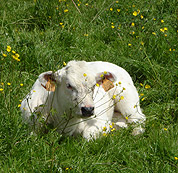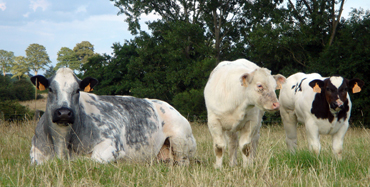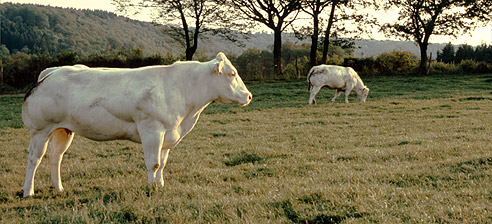Selection
In Belgium, selection based on the animal’s appearance and conformation has been practiced for many years and with much success. Our breeders have thus developed the Brabançon and Ardennes working horses, the Pietrain pig, the Belgian Landrace pig, the Beltex sheep and of course the Belgian Blue Beef cattle.
Today, the goal is to keep the superior muscling which allows the Belgian Blue to differentiate it self from other beef cattle, and through selection maintaining rusticity, size, posture, feet and legs...
Belgian Blue breeders created the Belgian Blue Herd-Book, which is entrusted with the selection, the registry of pedigrees and the promotion of the breed.
In Belgium, the number of active Belgian Blue breeders is around 2.000. The number of registered cows is 90.000 and that of registered bulls 2.500. Some 33.500 females and 1.900 males are registered annually in the Herd-Book.
| TO IMPROVE | TO KEEP | TO CONTROL |
| Stands | Conformation | Chest and back width |
| Fertility | Back length | |
| Rusticity & health | Docility | |
| Vitality (low death rate) |
Heigth (reference = heigth of 1st category and not the admission one) | |
| Hardiness (ability to drink) |
Size |
Parallel to the traditional selection methods which consists in choosing the good mating based on their pedigree and the classification at official competitions, a wide-range A.I. bull testing program has been set up.
> Table

Performance - test
Bulls from the performance-test are the result of preferential matings between A.I. or private bulls labeled as «bull fathers» and specially-chosen cows, most notably through their linear classification, and labeled as «bull mothers».
If these male calves meet the sanitary requirements, they are allowed into the Test-Station where they are raised in identical conditions until the age of 13 months.
The young bulls are subjected to daily gain, feed consumption and spermatogenesis evaluations.
At the age of 13 months, a severe selection takes place since only 50 % of the potential candidates are accepted for public auction where breeders and A.I. stations may bid for the bulls.
Progeny - test
The Progeny-Test involves the offspring of all A.I. sires.
Results (genetic evaluations) from these farm-based progeny tests are published biannually.
At the farm the controls start at calving (1st visit), and the calves are reexamined at 14 months of age (2nd visit). The collected data reflects the following zootechnical and functional traits:
- 1st visit (birth) : gestation length, birth weight, conformation, possible legs and mouth defects, vitality, death rate...
- 2nd visit (14 months) : weight, height, combined index weight-conformation, possible legs and mouth defects, death rate.

The linear score allows for :
- a periodic inventory of the morphological characteristics of the herd, whether this concerns a specific herd or the breed as a whole;
- the choice of bulls-mothers, with the purpose to enter male calves into the Bovine Selection station;
- the selection of future embryo donor cows;
- an highly specific genetic evaluation of the A.I. bulls.
A special system of linear scoring has been developed by the Belgian Blue Herd-Book for the breed. This evaluation is systematic for all the registered cows from 15 to 56 months of age.
The linear classification involves numerically scoring of each animal as to its morphology based on 22 traits : 4 for the size of the animal, 9 for the muscle development and 9 for the bone structure and posture.
Moreover, possible legs defects are taken in account: deviation rear- or forelegs, fetlock rear- or forelegs, sagged knee, puffy hocks.
Parallèlement, sont prises en compte les éventuelles anomalies d’aplombs : déviations et bouletures antérieures et postérieures, flexion des genoux, soufflettes aux jarrets.
> Exemple


